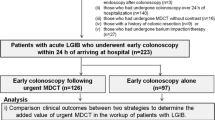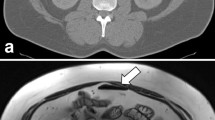Abstract
Background and Aims
To prospectively evaluate the role of contrast-enhanced computed tomography (CE-CT) in the detection of colonic diverticular bleeding (CDB).
Patients and Methods
Consecutive patients who presented with hematochezia and were clinically suspected of CDB were prospectively enrolled. Those who could undergo both CE-CT and total colonoscopy, and who were finally diagnosed as CDB, were included in the analysis.
Results
Fifty-two cases were finally included in the analysis. The detection rate of CDB by CT was 15.4 % (8/52). Univariate analysis showed that the interval from the latest episode of hematochezia to the performance of CT and the presence of a past history of CDB were contributing factors for detection. The interval was 1.6 ± 4.6 h (mean ± SD) in patients detected by CT, and 3.4 ± 3.2 h in those without detection. The detection rate of CDB by total colonoscopy was 38.5 % (20/52). The overall detection rate was 46.2 % (24/52), which was superior to what CT or colonoscopy alone achieved.
Conclusions
CE-CT may play a complementary role to colonoscopy in patients with suspected CDB, but is not recommended for all cases due to its low detection rate. Patients who can be examined within 2 h of last hematochezia would be candidates for urgent CT.



Similar content being viewed by others
References
Longstreth GF. Epidemiology and outcome of patients hospitalized with acute lower gastrointestinal hemorrhage: a population-based study. Am J Gastroenterol. 1997;92:419–424.
Stollman N, Raskin JB. Diverticular disease of the colon. Lancet. 2004;363:631–639.
Reinus JF, Brandt LJ. Vascular ectasias and divertilulosis: common causes of lower intestinal bleeding. Gastroenterol Clin North Am. 1994;23:1–20.
McGuire HH Jr, Haynes BW Jr. Massive hemorrhage for diverticulosis of the colon: guidelines for therapy based on bleeding patterns observed in fifty cases. Ann Surg. 1972;175:847–855.
Zuckerman GR, Prakash C. Acute lower intestinal bleeding: part II-etiology, therapy, and outcomes. Gastrointest Endosc. 1999;49:228–238.
Kang JY, Melville D, Maxwell JD. Epidemiology and management of diverticular disease of the colon. Drugs Aging. 2004;21:211–228.
Miura S, Kodaira S, Shatari T, Nishioka M, Hosoda Y, Hisa TK. Recent trends in diverticulosis of the right colon in Japan: retrospective review in a regional hospital. Dis Colon Rectum. 2000;43:1383–1389.
McGuire HH Jr. Bleeding colonic diverticula: a reappraisal of natural history and management. Ann Surg. 1994;220:653–656.
Potter GD, Sellin JH. Lower gastrointestinal bleeding. Gastroenterol Clin North Am. 1988;17:341–356.
Loffroy R, Cercueil JP, Guiu B, Krause D. Detection and localization of acute lower gastrointestinal bleeding prior to therapeutic endovascular embolization: a challenge! Am J Gastroenterol. 2009;104:3108–3109.
Baum ST. Arteriographic diagnosis and treatment of gastrointestinal bleeding. In: Abram H, ed. Abram’s Angiography, vol. 3. Philadelphia: Lippincott, Williams & Wilkins; 1997:25.
Alavi A, Ring EJ. Localization of gastrointestinal bleeding: superiority of 99mTc sulfur colloid compared with angiography. AJR. 1981;137:741–748.
Zink SI, Ohki SK, Stein B, et al. Noninvasive evaluation of active lower gastrointestinal bleeding: comparison between contrast-enhanced MDCT and 99mTc-labeled RBC scintigraphy. AJR. 2008;191:1107–1114.
Ettorre GC, Francioso G, Garribba AP, Fracella MR, Greco A, Farchi G. Helical CT angiography in gastrointestinal bleeding of obscure origin. AJR. 1997;168:727–731.
Ernst O, Bulois P, Saint-Drenant S, Leroy C, Paris JC, Sergent G. Helical CT in acute lower gastrointestinal bleeding. Eur Radiol. 2003;13:114–117.
Yoon W, Jeong YY, Shin SS, et al. Acute massive gastrointestinal bleeding: detection and localization with arterial phase multi-detector row helical CT. Radiology. 2006;239:160–167.
Scheffel H, Pfammatter T, Wildi S, Bauerfeind P, Marincek B, Alkadhi H. Acute gastrointestinal bleeding: detection of source and etiology with multi-detector-row CT. Eur Radiol. 2007;17:1555–1565.
Huprich JE, Fletcher JG, Alexander JA, Fielder JL, Burton SS, McCullough CH. Obscure gastrointestinal bleeding: evaluation with 64-section multiphase CT enterography-initial experience. Radiology. 2008;246:562–571.
Hara AK, Walker FB, Silva AC, Leighton JA. Preliminary estimate of triphasic CT enterography performance in hemodynamically stable patients with suspected gastrointestinal bleeding. AJR. 2009;193:1252–1260.
Kominami Y, Ohe H, Kobayashi S, et al. Dynamic computed tomography is useful for the diagnosis and colonoscopic treatment of colonic diverticular bleeding. Nihon Shokakibyo Gakkai Zasshi. 2011;108:223–230 (in Japanese with English abstract).
Jensen DM, Machicado GA, Jutabha R, Kovacs TOG. Urgent colonoscopy for the diagnosis of severe diverticular hemorrhage. N Engl J Med. 2000;342:78–82.
Smoot RL, Gostout CJ, Rajan E, et al. Is early colonoscopy after admission for acute diverticular bleeding needed? AJR. 2003;98:1996–1999.
Bloomfeld RS, Rockey DC, Shetzline MA. Endoscopic therapy of acute diverticular hemorrhage. AJR. 2001;96:2367–2372.
Hokama A, Uehara T, Nakayoshi T, et al. Utility of endoscopic hemoclipping for colonic diverticular bleeding. AJR. 1997;92:543–546.
Conflict of interest
None.
Author information
Authors and Affiliations
Corresponding author
Rights and permissions
About this article
Cite this article
Obana, T., Fujita, N., Sugita, R. et al. Prospective Evaluation of Contrast-Enhanced Computed Tomography for the Detection of Colonic Diverticular Bleeding. Dig Dis Sci 58, 1985–1990 (2013). https://doi.org/10.1007/s10620-013-2629-6
Received:
Accepted:
Published:
Issue Date:
DOI: https://doi.org/10.1007/s10620-013-2629-6




